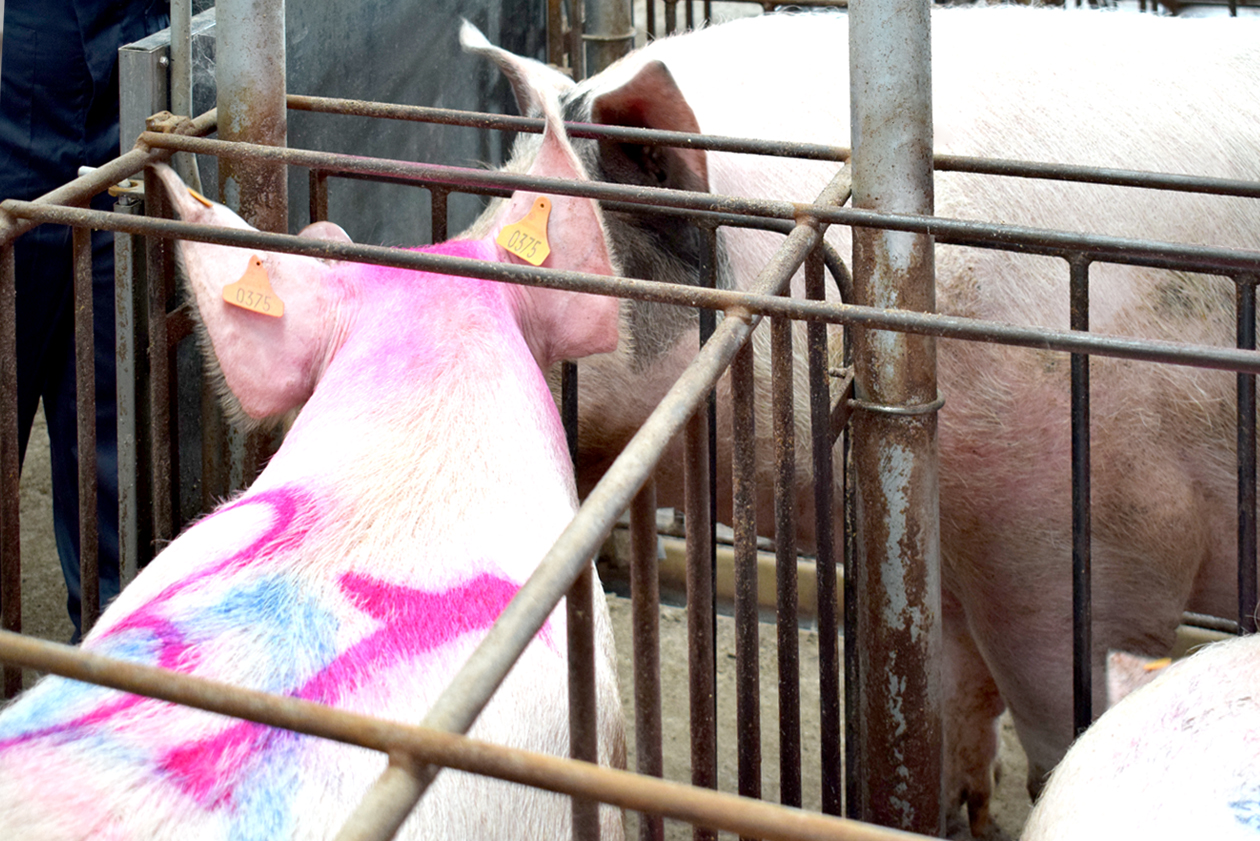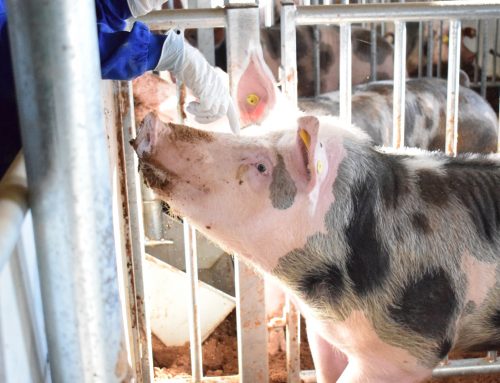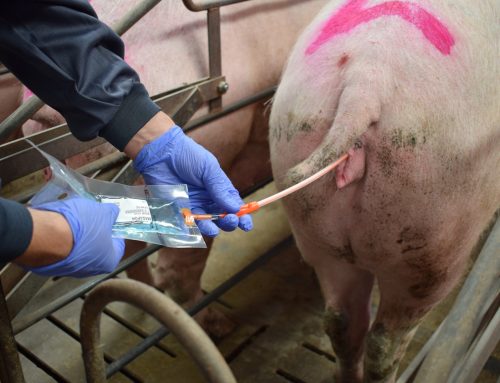In this section of the blog, we will talk about one of the most important tasks which require the maximum attention and skill of the operator, because much of the reproductive and productive parameters of the holding depend on the quality of the suspicion and insemination.
The task of stimulation after weaning and insemination is carried out during the parts of the sexual cycle called proestrus and estrus. This final period is characterized by being the moment during which the sow accepts the male and lasts two or three days, although in gilts is somewhat shorter (a little more than a day).
During this phase of the estrus cycle, the breeders show a marked sexual behavior, due to the high levels of estrogens. This behaviour is characterized by a rigid, immobile posture and erect ears in the presence of the boar, decreased appetite, a state of constant restlessness, and in group accommodation can be seen riding other females. Regarding external physical signs, edema and redness of the vulva can be observed. On many occasions, mucous and opaque vulvar exudate may be present, non-pathologic. From the beginning of both behavioral and physical signs, ovulation will occur spontaneously around 36-44 hours and lasts about 3-8 hours, in most cases, but it could be variable.
The two key points of the covering period are to correctly detect the heat and inseminate at the optimum time the highest % of sows. In this way, we will increase fertility and prolificacy, in addition, we will decrease the number of non-productive days of the farm. It seems a simple task, but it requires a high level of training and methodical work of the operator. We must consider that in this phase, we are risking the piglets that will be born in the next birth and this must be kept in mind by the staff of the service area.
During the stimulation, the boar is the most valuable “physical tool” when it comes to detecting and unleashing the heat of the breeders, and being “observant and paying attention to the details” are the best attributes of the person who detects the heat.
The boar produces a stimulus of the hypothalamic-pituitary-ovarian axis that will facilitate the coming into heat of the sows, but it must meet a number of characteristics:
- Must be a sexually mature animal (over 8-9 months old)
- Must be docil to facilitate handling
- Present a good libido and have a marked sexual odor
It is interesting to use more than one boar, since the stimulation capacity of each male is about 20-30 minutes, and then begins to decline. In addition, if we stimulate the sows with boars enclosed in the corridor, we will speed up the process, since it is preferable to use two boars and keep them along the corridor, than to use only one for the whole row of sows as it will produce a deficient stimulus and we can lose precision in the detection of the heat.
For the correct detection of the heat, as we have mentioned before we will use a male that will interact with the sows located in rows of individual cages through the central corridor, in this way he will be able to establish a sufficient contact with the breeders. It is interesting that this corridor has separations or barriers every 6-8 meters, which allow to contain the boar the necessary time. We have to keep in mind that a boar will cause stimulation in no more than six sows, which will be the two with which it has contact, the two that are in front, and the two that are behind.
The operators will be located on the other side, behind the sows, and they must stimulate and detect the heat of the sows that are parallel to the male. We have to mention that the boar will not only produce a reaction in the sows in front of it, it will also do so in sows that have a hormonal or visual stimulus, but this is also called a “male effect”.
It should be noted that sows are not always weaned directly in cages, there are many production systems in which weaning is carried out or is forced to be carried out in pens/parks. It is important to carry out separation by size within batches. The suspicion system is done in the same way as in individual boxes:
- Stimulate the sows from the first day, introducing the males into the park, to guarantee their stimulation.
- Make small groups <10 sows and with enough space 2-3m² per animal.
- It is preferably inseminating with the post-cervical technique at the same time as it is stimulated to facilitate handling.
Both in individual boxes and in parks, the operators will check which females have the signs mentioned at the beginning of the text, edema, redness and exudate vulvar exudate and especially the immobilization reflex and will proceed to identify them for later insemination. Here are different strategies to identify at what moment and day each sow has come into heat and therefore which day it is time to cover or if it has already been covered.
- Colours: one color per week
- Strokes: longitudinal or transverse line depending on morning or afternoon
- Points: for each insemination
It is interesting to carry out the stimulation at a quiet hour, this is usually about 45 minutes after the sows have eaten to avoid interactions with the nervousness that occurs in the animals at the time of the meal. It is important to keep a work routine and always do it at the same hour, in this way we will also make it easier for the same staff to always do it. The action must be carried out in a quiet way, treating the sows with softness without hitting and always warning that it will be manipulated, but we must also apply some pressure on the back to make sure that the reflection of immobility is positive or not, in addition to paying attention to the other signs that present during the heat. It is also convenient, if working hours allow it, to make two stimulations daily, one in the morning and one in the afternoon, this allows us to detect the highest number of heats possible and better limit the insemination pattern. Any distraction should be avoided, such as noises caused by different machinery, give a drink at that time, perform any type of treatment…
Once the start of the heat has been detected, it is also important to control how long it lasts and when it ends, so as we will discuss later, we will be able to better adjust the optimal insemination time. In addition, late inseminations, that is, once the heat has finished, can lead to future reproductive pathologies such as endometritis and pyometrics.
Finally, we will briefly comment on the moment of insemination, since in order to choose an insemination pattern, the duration and dynamics of the heat should be studied and known, of the farm for which you want to establish, since it can be a dependent farm factor.
As we have commented in previous posts and we have recalled at the beginning of this one, the heat lasts about two or three days and ovulation occurs on most occasions at the beginning of the last third of this period. Regarding the heat in “weaned” multiparous breeders, we can divide into three groups, long heat, “normal” heat and short jealousy.
We consider that the sows that show symptoms of heat in the first three days after weaning, they will have a long heat (72 hours). Sows that come out in heat from the fourth day until the sixth day after weaning are considered to be sows with normal heat (48 hours) and sows that leave from the seventh day will be considered to have a short heat (24 h).
For this reason, it is important to ensure the presence of sperm of quality and in sufficient quantity at the time of ovulation, for this, we must have inseminated in the 24 hours prior to breeding, this is where the difficulty comes, to achieve the greatest fertilization using the lowest number of doses possible.
Fertility and prolificacy are highly influenced by the interval between insemination and ovulation since this interval greatly affects sperm viability, the longer time passes between insemination and ovulation, lower sperm viability in the oviduct reservoir. The best results were observed in inseminated females 24 hours before ovulation and 4 hours after ovulation. It should be noted that inseminations too early or too late regarding ovulation could reduce fertility, decrease fertility and even produce endometritis in the case of very late inseminations.
So far this week post. With these tips we hope to have helped in the knowledge of what are the factors involved in the detection of heat and the optimal moment of insemination. It should be noted that we have not referred to any hormonal treatment protocol due to the complexity of the subject. In the next blog posts, we will talk about the management of gilts to optimize coming into heat.
See you soon!
BIBLIOGRAPHY
https://www.pig333.com/articles/stimulation-and-mating-of-sows-in-stalls-i_7424/
https://www.pig333.com/articles/tips-for-heat-detection-in-gilts-and-sows_15469/
Mc Donald LE, Pineda MH. Veterinary Endocrinology and Reproduction. Lea& Febiger, 1991.
Falceto, M.V., Duque, C., Alfonso, J., Ciudad, M.J., Espinosa, E. (2004) Variaciones Fisiológicas de la funcionalidad ovárica en la cerda. Porci. 82: 11-32.
Compagnoni, M.V., Tittarelli, C. M., Williams, S.I., (2019) Artificial insemination in the swine species: inseminating dose related to the deposition place. Analecta veterinary Journal, 39: 33-46.



